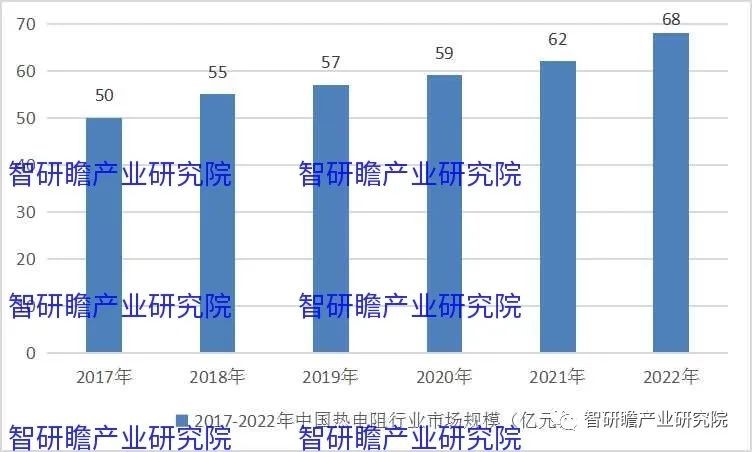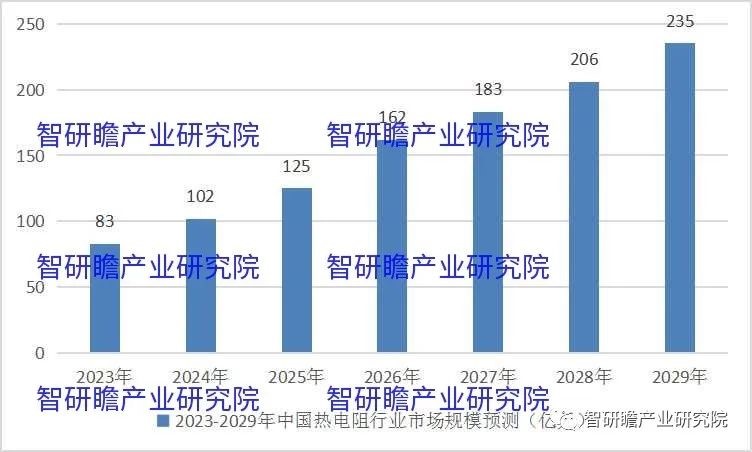Definition of thermal resistor
Thermal resistor is an electronic component whose resistor value changes with the change of temperature within a certain temperature range. Generally, the resistor value of thermal resistor will increase with the increase of temperature or decrease with the decrease of temperature, and this relationship can be expressed by the temperature characteristic curve of thermal resistor. Thermal resistor is mainly affected by temperature coefficient and geometric structure of materials. Common thermal resistors include platinum resistors, nickel resistors, copper resistors, etc. Platinum resistors have high accuracy and good stability, and are widely used in the field of temperature measurement.
Classification of thermal resistor
Metallic thermal resistor
Such as platinum resistor, nickel resistor, copper resistor, etc., using the characteristics of metal resistor changing with temperature.
Semiconductor thermal resistor
Mainly made of semiconductor materials, such as silicon, germanium, tellurium and other elements, it has good sensitivity and response speed, and can work in high temperature environment.
Carbon film thermal resistor
The thin films made of chromium, nickel and graphite have the advantages of small volume, light weight and fast response speed.
Platinum-rhodium thermocouple
It is composed of platinum and rhodium, which is widely used in temperature measurement because of its high stability and precision.
Ferrite thermocouple
It is composed of ferrite and doped elements (such as molybdenum, cobalt, etc.), and is mainly used for temperature measurement in high temperature environment.
Magnetostrictive thermal resistor
It is made of magnetic materials such as iron and nickel, and realizes temperature measurement through the coupling effect of magnetization and strain.
Thermal resistor band
By adding impurities or changing the structure of the crystal to improve its thermoelectric characteristics, the thermal resistor element with high sensitivity can be obtained.
Advantages of thermal resistor
High precision
Because there is a linear relationship between the characteristics of thermal resistor and temperature, its measurement accuracy is high.
Good stability
Because thermal resistor is not easily affected by mechanical, chemical and other environmental factors, its service life is long and its stability is good.
Fast response speed
Compared with other temperature measuring elements (such as thermocouples), thermal resistor has faster response speed and can realize more timely temperature detection.
High reliability
Because of its high sensitivity and precision, thermal resistor can work stably in various complex environments, so its reliability is higher.
Disadvantages of thermal resistor
Expensive
Compared with other temperature measuring elements, such as thermocouples and thermoelectric deviation meters, the cost of thermal resistors is higher.
Low sensitivity
Although thermal resistor has high precision, its sensitivity is relatively low, and small temperature change may lead to measurement error.
Complex structure
The manufacture and use of thermal resistor need precise machining technology and detection method, which is complicated.
Be limited by temperature
Because different kinds of thermal resistors have different operating temperature ranges, their applications are limited by certain temperatures.
Development history of thermal resistor
In 1821, German physicist Seebeck discovered that when two different metals are connected to form a closed circuit, there will be a potential difference under the action of temperature difference, that is, thermoelectric effect. In 1833, another German physicist, Constantine, discovered that when the current flowing between two different metals reverses in direction, the endothermic and exothermic phenomena will change accordingly, that is, Constantine effect. In 1871, British physicist BollinGer first proposed to use platinum resistor to measure temperature.
In 1887, French physicist Julian applied platinum resistor to industrial thermometers. In 1901, American Emmonson put forward the method of using platinum-rhodium thermocouple to realize high-precision temperature measurement. In 1930s, thermal resistor was widely used in the field of industrial temperature measurement because of its good stability and wide linear range. In 1948, the international standard unit of thermal resistor PT100 was officially established. PT100 is a thermal resistor element made of platinum, which has stable performance and high precision, and is widely used in the field of temperature measurement. After 1980s, with the continuous progress of materials science and technology and microelectronics technology, new thermoelectric materials and thermal resistor sensors emerged constantly, such as carbon nanotube thermal resistor and semiconductor thermal resistor, which promoted the continuous development and innovation of thermal resistor technology.
Upper, middle and lower reaches of thermal resistor
Upstream is thermal resistor material and preparation. It mainly includes manufacturers of platinum, nickel, copper and other metal materials and semiconductor materials, as well as related preparation technology research institutions. The middle reaches are the production and testing of thermal resistor components. It mainly involves the processing, manufacturing, assembly and testing of thermal resistor elements. The main participants in this link include sensor manufacturers and measuring instrument manufacturers. Downstream mainly includes industries with high requirements for temperature measurement accuracy in aerospace, electric power, medicine, chemical industry and other fields. In addition, with the development of Internet of Things, smart home and other technologies, thermal resistor also has a wide application prospect in the intelligent field.

Figure1: Data source: Zhiyanzhan
Market size of thermal resistor
In 2017, the scale of China's thermal resistor market was about RMB 5 billion, an increase of about 10% year-on-year. In 2018, the scale of China's thermal resistor market was about 5.5 billion yuan, an increase of about 10% year-on-year. In 2019, due to the increasing uncertainty of the global economic situation and the influence of Sino-US trade friction, the growth of China's thermal resistor market slowed down slightly, with a market size of about 5.7 billion yuan, an increase of about 5% year-on-year. In 2020, due to the global economic contraction caused by COVID-19 pandemic and the impact of domestic industrial chain, the growth rate of China's thermal resistor market declined, with a market size of about 5.9 billion yuan, an increase of about 3.5% year-on-year.
Statistics show that the market size of China's thermal resistor industry is 5 billion yuan in 2017 and 6.8 billion yuan in 2022. The market size of China's thermal resistor industry from 2017 to 2022 is as follows:

Figure2:Market size of China's thermal resistor industry from 2017 to 2022
According to the forecast, the market size of China's thermal resistor industry will be 23.5 billion yuan in 2029.

Figure3:Forecast of market scale of China's thermal resistor industry from 2023 to 2029
It is estimated that by 2025, the global thermistor market will reach 4.42 billion US dollars, showing a continuous growth trend. In China's sensor market, temperature sensors (including thermocouples and thermal resistors) account for the largest proportion, and the market demand is increasing. There are many participants in the thermal resistor industry, mainly including Shanghai KSTAR, Jiangsu CHINT Instrument, Tianjin Jincheng Thermal Power, Hailaer Technology and so on.
Development policy of thermal resistor
"Made in China 2025" puts forward the goal of strengthening the industrialization and intelligent development of new sensors, encourages enterprises to intensify innovation in technology, products and markets, and promotes technological upgrading and industrial transformation in sensor fields such as thermal resistor. In 2016, the National Development and Reform Commission and the Ministry of Industry and Information Technology jointly issued the Guiding Opinions on Promoting the High-quality Development of Sensor Industry, proposing to support sensor research institutions and enterprises to carry out basic research and application development, and strengthen the construction of industry standard system. The Development Plan of China's Electronic Information Industry (2016-2020) proposes to accelerate the independent controllable and industrialized development of key components such as integrated circuits and sensors, and promote the technological innovation and application of sensors such as thermal resistors.
Detailed analysis of obstacles to the development of thermal resistor
Technical bottleneck
Although thermal resistor technology is relatively mature, there are still some technical bottlenecks, such as temperature range, accuracy and stability.
Lack of industry standards
Due to the production standards and specifications of thermal resistor products have not been formulated uniformly, there are products with uneven quality in the market, which affects the development of the whole industry.
The high-end market is limited
There is a great demand for thermal resistor products in the domestic high-end market, but the market share of domestic enterprises in the high-end market is low, which makes some high-end markets monopolized by foreign brands.
Cost pressure
With the rise of raw material prices and labor costs, the production cost of thermal resistor products is gradually increasing, which is a challenge for enterprises in the thermal resistor industry.
Intense competition
At present, there are many participants in China's thermal resistor industry, and the market competition is fierce. In this case, enterprises need to constantly strengthen their own technological innovation and product quality in order to maintain competitiveness in the market.

Figure4: Data source: Zhiyanzhan
Detailed analysis of development space of thermal resistor
With the higher and higher requirements for temperature measurement accuracy and stability in various industries, the application fields of thermal resistor will continue to expand, such as electric power, chemical industry, medicine, food and other fields need to use thermal resistor for temperature measurement. Although thermal resistor technology is relatively mature, with the improvement of technical level and the application of new materials, the temperature range, accuracy and stability of thermal resistor products will be continuously improved, thus broadening the application range of thermal resistance.
With the development of Internet of Things, intelligent manufacturing, smart home and other technologies, the intelligent demand for sensors such as thermal resistance is also increasing. This will drive the thermal resistance industry to transform towards intelligence and automation, and bring more business opportunities to enterprises. With the continuous expansion of the domestic market and the upgrading of consumption, the sales of sensor products such as thermal resistors are also increasing year by year. It is predicted that the scale of China's thermal resistor market will continue to maintain a high growth rate in the next few years.
In recent years, some innovative enterprises have emerged in the thermal resistor industry. These enterprises constantly strengthen their own technological innovation and product quality, actively expand domestic and foreign markets, and have achieved obvious market advantages in some fields. Generally speaking, the thermal resistor industry has broad development space and market prospects, especially in the expansion of application fields, the increase of intelligent demand and the potential of domestic market.
Intelligent demand brings broad business opportunities. In 2025, the thermal resistance market may exceed 4.42 billion-China.exportsemi.com






